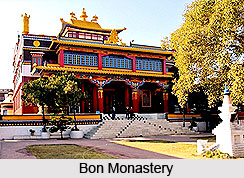 Bon Monastery, also called Yung Drung Ling, is situated at a distance of 18km from Solan town, in Solan district in Himachal Pradesh. It is considered the second oldest monastery in the world, only after the one present in Tibet. Bon monastery houses a massive statue of Lord Shenrab Mibo.
Bon Monastery, also called Yung Drung Ling, is situated at a distance of 18km from Solan town, in Solan district in Himachal Pradesh. It is considered the second oldest monastery in the world, only after the one present in Tibet. Bon monastery houses a massive statue of Lord Shenrab Mibo.
The monastery belongs to the Bon religion which is older than the Buddhist religion, although the principles are the same. Bon originated in the land of Olmo Lungring, located in Tazig. `Ol` means the unborn, `Mo` means indestructible and `Lung` is the divinatory words of Tonpa Shenrab, the founder of Bon religion.
Although they track their origins to olden days, Bonpo implement a living set of guidelines devoted to perpetuating the lessons of their creator Tonpa Shenrab, who consumes a prominent place in Bon lifestyle just like that of Sakyamuni in Buddhism. Tonpa Shenrab`s lessons are jointly known as Yung Drung Bon or the "tradition of Everlasting Wisdom" and consist of the Nine Methods of Bon that summarize the rules of cause and impact on the direction to religious freedom.
History of Bon Monastery
The monastery was founded by the Abbopt Lungtog Tenpai Nyima in 1969. Three sanctified Bon dances (Cham) are performed on New Year Eve that draws a lot of devotees to the religious institution. Chiselled with a yellow roofed chapel and a number of flags darting on the rooftops, the Bon monastery is a perfect tourist target.
Role of the Chief Lama
The chief lama of the Monastery is Menri Trizin, who is also the head of all other Bonpo monasteries. The 80 years old lama still maintains his holy schedule along with taking care of the monastery functions. On a daily basis he assigns tasks to the monks, participates in the religious ceremonies, receives the visitors, dictates letters, and supervises the construction and education projects. Menri Trizin performs his role as a true spiritual leader of the Bonpo.
Prayer at Bon Monastery
The interesting difference from the Buddhist tradition is that in Buddhism the monks go clockwise to circle a temple while praying whereas in the Bon religion they go anti clockwise. Huge conches are used during prayers. This huge colourful monastery is a place of peace and serenity and attracts a lot of tourists every.



















